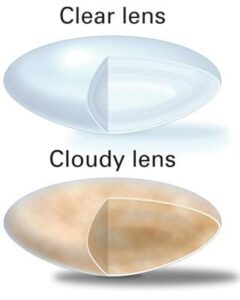Cataract
About Cataract
What is a Cataract?

Vision Problems with Cataracts

Cataracts Symptoms
- Having blurry vision
- Seeing double (when you see two images instead of one)
- Being extra sensitive to light
- Having trouble seeing well at night, or needing more light when you read
- Seeing bright colors as faded or yellow instead


Cataracts Cause
Most cataracts develop when aging or injury changes the tissue that makes up your eye’s lens. Some inherited genetic disorders that cause other health problems can increase your risk of cataracts. Cataracts can also be caused by other eye conditions, past eye surgery or medical conditions such as diabetes. Long-term use of steroid medications, too, can cause cataracts to develop.
Factors that increase your risk of cataracts include:
- Increasing age
- Diabetes
- Excessive exposure to sunlight
- Smoking
- Obesity
- High blood pressure
- Previous eye injury or inflammation
- Previous eye surgery
- Prolonged use of corticosteroid medications
- Drinking excessive amounts of alcohol

Frequently Asked Questions
Answer: Cataract is a disease of eye in which transparent lens of the eyes start turning opaque, which interferes with passage of light into the eye, causing blurred vision.
Answer: No, cataract is an age related change in the eye. Cataract causes temporary blindness or vision impairment, which can be restored with treatment.
Answer: Increasing age is most common cause of cataract. Such cataract are called senile cataract.
Answer: Everyone. The risk of glaucoma increases with increase in age. The risk rises after age of 50 years. Some type of cataract may be present at birth or may start in early childhood or young age. Other risk factors are use of some drugs like steroids, repeated inflammations in eye, injury to eye, some systemic metabolic diseases like diabetes mellitus, Calcium level derangement, thyroid dysfunction etc.
Answer: Yes, cataract is treatable completely, provided the intervention is done in time.
Answer: An untreated cataract may lead to complications in eye, usually a type of glaucoma called lens induced glaucoma or inflammation in eyes.
Answer: The current management of cataract is surgical. The drugs or eye drops can halt progression or reverse changes of cataract.
Answer: In general, the opaque or cloudy natural lens (cataract) is extracted using one of several techniques available, and an artificial lens called intra-ocular lens (IOL) is implanted in eye. The most common technique for cataract extraction is phacoemulsification. However, depending upon type of cataract and condition of cornea, other techniques may be used for lens extraction.
Answer: There are several types of IOLs available now days. They may be suited for distance, near and intermediate vision or may encompass all in one.
The type of lens may vary depending upon your visual needs. You can choose appropriate lens after discussing with your eye doctor or counselor.
The cataract surgery can be done in any season of the year.
Answer: No, generally you can resume your routines after 3-4 days. If there are specific precautions after surgery, your eye doctor would tell you in advance.

